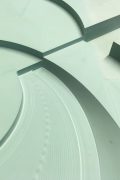For a Theatre on Mars provides both a functional space for, and a sculptural object in the city gallery of Ostrava, PLATO. Its intended programme is that of a space for all kinds of live performance – be it an intimate reading or an expansive dance performance. A collaboration between Than Hussein Clark and us, the stage was conceived as an open platform, activated by the interplay between performers and audience. The layout of the stage takes its form from the floor plan of the Totaltheater by Walter Gropius and Erwin Piscator. Initially we created a whole taxonomy of (im)possible theatres based on the Modernist prototype. Building upon these experiments, we developed a theatrical landscape – related to the outlines of the Totaltheatre’s floorplan, but completely different in its topography.
Whereas the (unrealised) original was to draw its flexibility from rotating platforms and variable spaces, For a Theatre on Mars offers flexibility only in that it can be inhabited in various ways. As it provides no clearly defined zones for specific activities – and therefore no predetermined spaces reserved for either performers or audience – it has to be reinterpreted during every event and performance.


Given the problematic, but, at least in recent years, undisputedly intense relationship between contemporary art and theatre we invited Than Hussein Clark (b. 1981, USA). His work attempts to re-evaluate the seemingly false nature of theatrical art as opposed to the proclaimed universality and truthfulness of traditional modern art, blending in the subjects of citizenship, belonging, decadence and gay culture. The stage project – on which he collaborated with design practice CPWH – has been informed by the design for a total theatre by Walter Gropius from 1926, by the circular space in front of the Ostrava main railway station and, as far as its final appearance is concerned, possibly by a skatepark. The original design by Gropius, drawn up during the architect‘s engagement at the Bauhaus art school, was to have combined three types of stage within a mechanically variable space: a circular arena, a semi-circular ancient proscenium and a classic depth perspective theatre. Than Hussein Clark has adopted this model to some extent but simultaneously transformed it into an abstract sculptural installation and flattened it into a human dimension. The stage is a kind of an open plate bringing to mind art deco ceramic dishes and the spaceship Enterprise from Star Trek. The drapery around the walls partly isolates the inside but at the same time its translucent sections visualise and highlight it from the outside. In this way the action inside the room, whether on stage or in the auditorium, is dramatised and voyeurised. In their repeating precisely related dimensions the dynamic shapes of the dish are both aesthetic and functional, they are an abstract sculpture and a technologically sophisticated stage. The stage’s circular forms make the viewers simultaneously into the observed and the stage continually unites physical activity and view, inviting us not just to contemplate but also to enter, use and experience.
Michal Novotný










